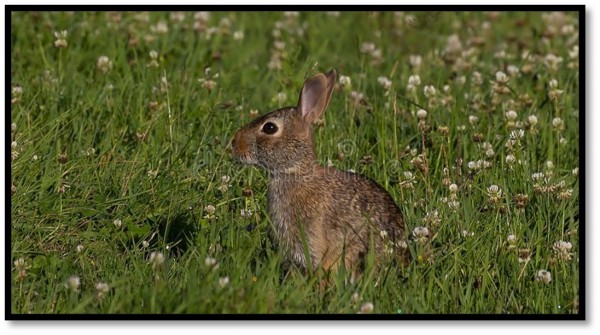Eastern Cottontail Rabbit
 Eastern Cottontail Rabbit
Eastern Cottontail Rabbit
Sylvilagus flondanus
-
Eastern cottontail rabbits are members of the Leporidae family, which includes over 60 species of rabbits and hares.
-
Often referred to as cottontails, the eastern cottontail rabbit can grow to be 14 to 18 inches in length and can weigh up to 4 pounds. The female cottontail is always larger than the male
-
Rabbits use the technique of “freezing” in place when trying to avoid being noticed by predators. If this technique does not work, rabbits will flee in a zig-zag pattern.
Population: Rabbits are common throughout Wisconsin but are most abundant in the southern two-thirds and northeastern part of the state. Rabbits can be hunted during a limited season with a small game license from the DNR.
Habits: Rabbits can be found living in a variety of habitats across the state, though they mostly prefer sparsely wooded areas, thick brush, orchards, and farmland. Rabbits usually live their entire lives within a 20-acre radius and can be seen year-round at any time of day.
Rabbits have excellent sight and large ears that stand up straight to hear noises coming from all directions. Rabbits like to have an escape route and can run as fast as 18 mph for a half-mile distance if fleeing from predators. Rabbits can be seen as a nuisance to gardeners and farmers as they can cause damage to flowers, vegetables, and crops.
Diet: Rabbits are herbivores and love to snack on sprouts, alfalfa, beans, dandelions, and garden plants. Rabbits have sharp incisors that constantly grow and are perfect for gnawing on plants and bark. During the winter months, rabbits will snack on the tender parts of an apple, birch, maple, and sumac tree.
Mating and Young: Rabbits will start mating in the early spring and can have up to six litters in a year due to the fact that the female can reproduce again almost immediately after giving birth. Before giving birth, the female rabbit will make a small depression in the ground and fill it with grass and fur for warmth. The female will then give birth in her nest to five or six babies, known as leverets, after a gestation period of thirty days. Leverets are born weighing roughly one ounce, without fur, and are blind. After only five weeks, the leverets are fully weaned and independent, and by four months of age are considered mature.
Information from: http://wildlifedamage.uwex.edu/pdf/Rabbit.pdf, https://www.wxpr.org/post/rabbits-and-hares-oh-my#stream/0 and https://www.eekwi.org/animals/mammals/cottontail-rabbit
To download this info: Click Here
